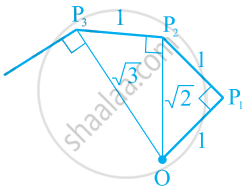Advertisements
Advertisements
प्रश्न
Examine, whether the following number are rational or irrational:
`2+sqrt3`
उत्तर
Let `x=2+sqrt3` be the rational
squaring on both sides
`rArrx^2=(2+sqer3)^2`
`rArrx^2=4+3+4sqrt3`
`rArrx^2=7+4sqrt3`
`rArrx^2-7=4sqrt3`
`rArr(x^2-7)/4=sqrt3`
Since, x is rational
⇒ x2 is rational
⇒ x2 - 7 is rational
`rArr(x^2-7)/4` is rational
`rArr sqrt3` is rational
But, `sqrt3` is irrational
So, we arrive at a contradiction.
Hence, `2+sqrt3` is an irrational number.
APPEARS IN
संबंधित प्रश्न
Identify the following as rational or irrational number. Give the decimal representation of rational number:
`sqrt(9/27)`
Prove that (4 - 5`sqrt(2)` ) is irrational.
State, whether the following numbers is rational or not : ( 2 + √2 )2
State, whether the following numbers is rational or not :
`( 3/[2sqrt2])^2`
Prove that the following number is irrational: √3 + √2
Check whether the square of the following is rational or irrational:
`sqrt(2) + sqrt(3)`
Insert five irrational number's between `2sqrt(3) and 3sqrt(5)`.
The product of a rational and irrational number is ______.
Classify the following number as rational or irrational with justification:
`(1 + sqrt(5)) - (4 + sqrt(5))`
Classroom activity (Constructing the ‘square root spiral’): Take a large sheet of paper and construct the ‘square root spiral’ in the following fashion. Start with a point O and draw a line segment OP1 of unit length. Draw a line segment P1 P2 perpendicular to OP1 of unit length. Now draw a line segment P2 P3 perpendicular to OP2. Then draw a line segment P3 P4 perpendicular to OP3. Continuing in this manner, you can get the line segment Pn–1Pn by drawing a line segment of unit length perpendicular to OPn–1. In this manner, you will have created the points P2, P3,...., Pn,.... ., and joined them to create a beautiful spiral depicting `sqrt2, sqrt3, sqrt4,` ...

